10 Real Estate Software Development Companies in 2025
- February 03
- 9 min

The real estate industry is in the middle of a massive digital shift, with virtual tours and augmented reality (AR) leading the charge. These technologies are the next major wave in Property Technology (PropTech), changing the very nature of how properties are marketed, viewed, and sold. By breaking free from the limits of static photos and inconvenient open houses, AR and VR are creating immersive, transparent, and efficient experiences for everyone involved. This isn’t just a fleeting trend; it’s a foundational change that’s setting a new standard for buying and selling property.
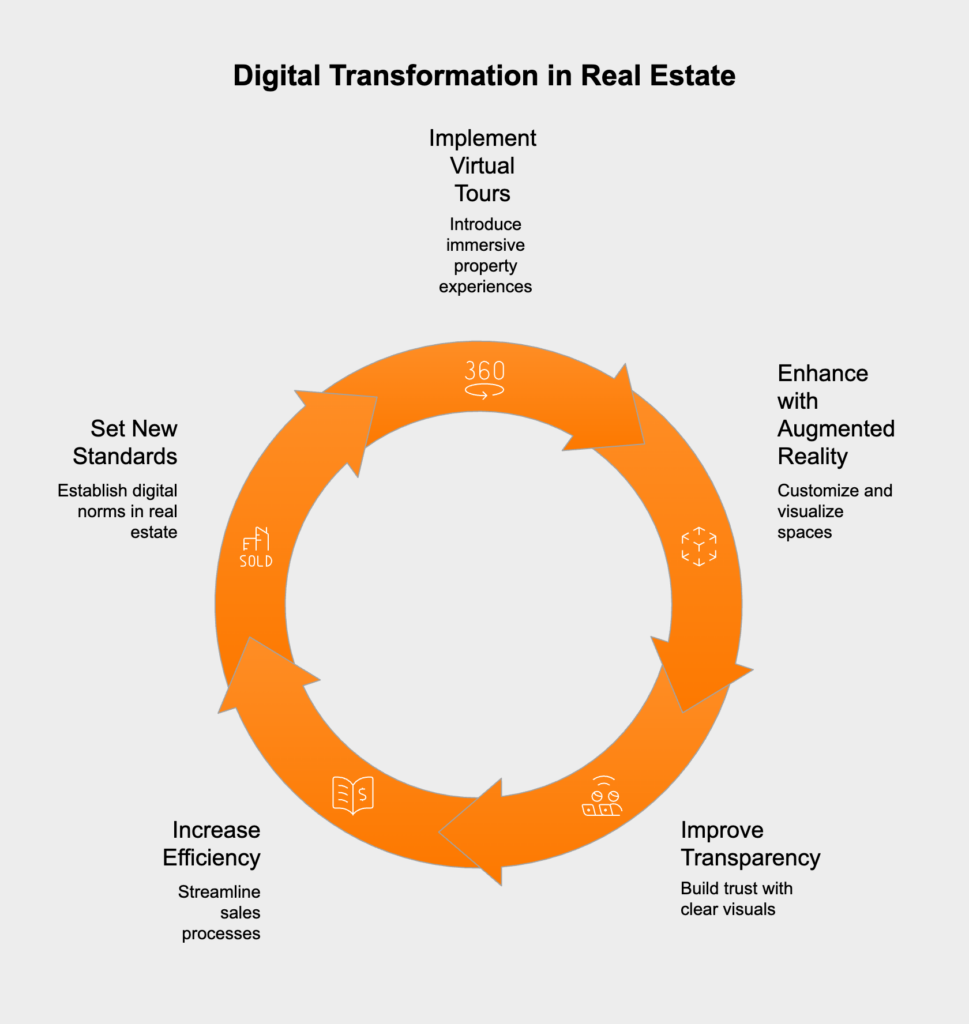
Virtual tours and augmented reality are the new frontier in PropTech because they solve old problems in the property sales cycle. They turn passive viewing into active exploration, giving buyers more information and control than ever before. This leap from flat, 2D images to dynamic, 3D worlds builds trust and speeds up decision-making, marking a huge step forward in how real estate deals get done.
For years, property marketing depended on carefully selected photos that offered a limited, often idealized, peek at a space. Virtual tours and AR completely change this by providing immersive and interactive experiences that feel like you’re actually there. Instead of just looking at a photo of a living room, potential buyers can digitally “walk” through the house, control their own path, and look in any direction they choose. This creates a powerful sense of presence and spatial awareness that static images can’t match, helping people accurately grasp a property’s layout, flow, and scale.
Though often mentioned together, these two technologies have different but complementary roles. 3D and 360° virtual tours create a complete “digital twin” of an existing property, letting someone explore it as-is from anywhere. This is done by stitching together high-resolution photos or using special cameras to create a detailed 3D model. In contrast, augmented reality adds digital information onto a real-world view, usually through a smartphone or tablet. AR doesn’t replace the physical environment but enhances it, allowing users to place virtual furniture in an empty room, test different paint colors, or even see a finished building on an empty lot.
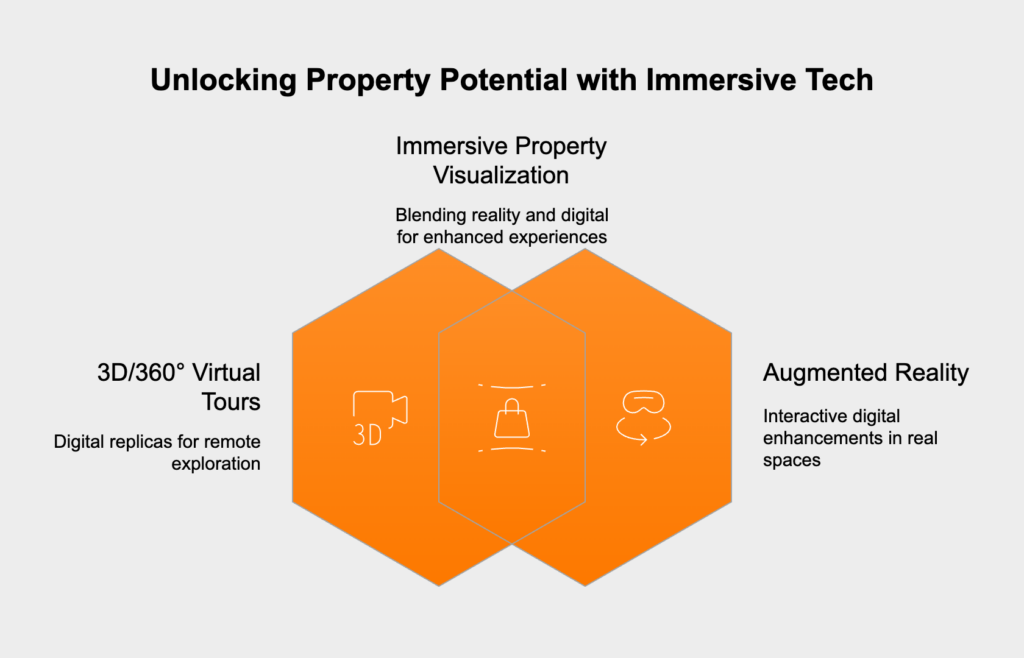
One of the biggest benefits of this technology is how it builds trust and transparency. A high-quality virtual tour shows a property in its entirety—including awkward layouts or minor flaws that might be hidden in staged photos. This honest perspective gives buyers a more complete picture of what they’re considering. By offering this comprehensive view upfront, sellers and agents show confidence in their listing and help buyers make better-informed choices. This early transparency reduces the chance of surprises during a physical visit and builds a solid foundation of trust right away.
For property buyers, virtual tours turn a once-draining process into an experience defined by convenience and confidence. The ability to vet properties thoroughly from a distance opens up the market and gives buyers more control. This remote viewing capability is no longer a gimmick but a vital tool that boosts engagement, speeds up shortlisting, and creates a real connection to a potential home before a buyer ever steps inside.
The main game-changer for buyers is the power to conduct detailed initial viewings from anywhere. With 3D and 360° walkthroughs, a buyer across the country can explore every corner of a home just as if they were there in person. They can move between rooms, check ceiling heights, inspect finishes, and get a true feel for the layout. This is especially transformative for long-distance relocations and international investors, who can now evaluate properties with confidence without needing to travel immediately.
Virtual tours speed up the sales process by helping buyers create highly qualified shortlists online. Instead of scheduling physical viewings for homes that might not be right, buyers can quickly rule out properties that don’t fit their needs after the virtual walkthrough. This saves a huge amount of time for both the buyer and the agent. By the time a buyer schedules an in-person visit, they’re already seriously interested, making the showing more productive and increasing the odds of an offer. This smart pre-qualification leads to faster deals and fewer wasted appointments.
Listings with virtual tours consistently see higher online engagement. Buyers spend more time exploring these properties, which helps them build a stronger connection and a clearer mental map of the space. This deeper interaction builds confidence in the property’s layout, size, and condition. Understanding how rooms connect is critical for a buyer, and a virtual tour delivers this context much more effectively than a floor plan or photo gallery ever could. This confidence often leads to a quicker, more decisive purchase.
Augmented reality pushes property visualization even further, helping buyers see not just what a property is, but what it *could be*. By layering digital information onto the real world, AR allows for on-the-fly customization, brings unbuilt projects to life, and showcases a home’s hidden potential. This makes it an incredibly powerful tool for selling both new construction and existing homes.
It’s often hard for buyers to imagine how their own furniture and style will look in an empty or unfamiliar space. AR solves this by letting them virtually customize a property in real time. Using a smartphone, a buyer can point their camera at a room and instantly see it with different wall colors, test out virtual furniture arrangements, or even visualize a small renovation, like removing a wall. This interactive process helps buyers form an emotional connection and truly picture themselves living in the home.
AR is a game-changer for selling off-plan properties. Convincing someone to invest in a home that doesn’t exist yet is a tough sell based on blueprints alone. Augmented reality helps pre-sell these properties by giving clients a realistic preview of the final product. A potential buyer can stand on the construction site, hold up an AR-enabled device, and see a full-scale digital model of the future building right where it will stand. This gives them a tangible sense of the property’s scale, views, and surroundings that drawings can’t provide.
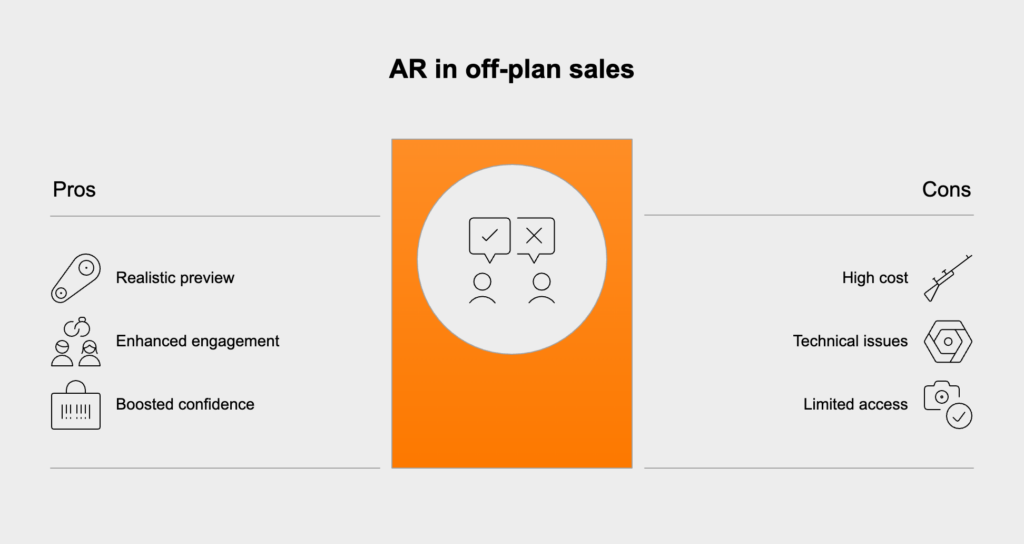
Physically staging a home boosts its appeal, but it’s expensive, time-consuming, and not always practical. Digital staging with AR is a flexible and cost-effective solution. Agents can use AR to fill an empty house with stylish, virtual furniture and decor, allowing them to showcase a home’s potential without bringing in a single physical item. This helps buyers get past the “empty room” feeling and better envision how each space can be used, making the property far more appealing and memorable.
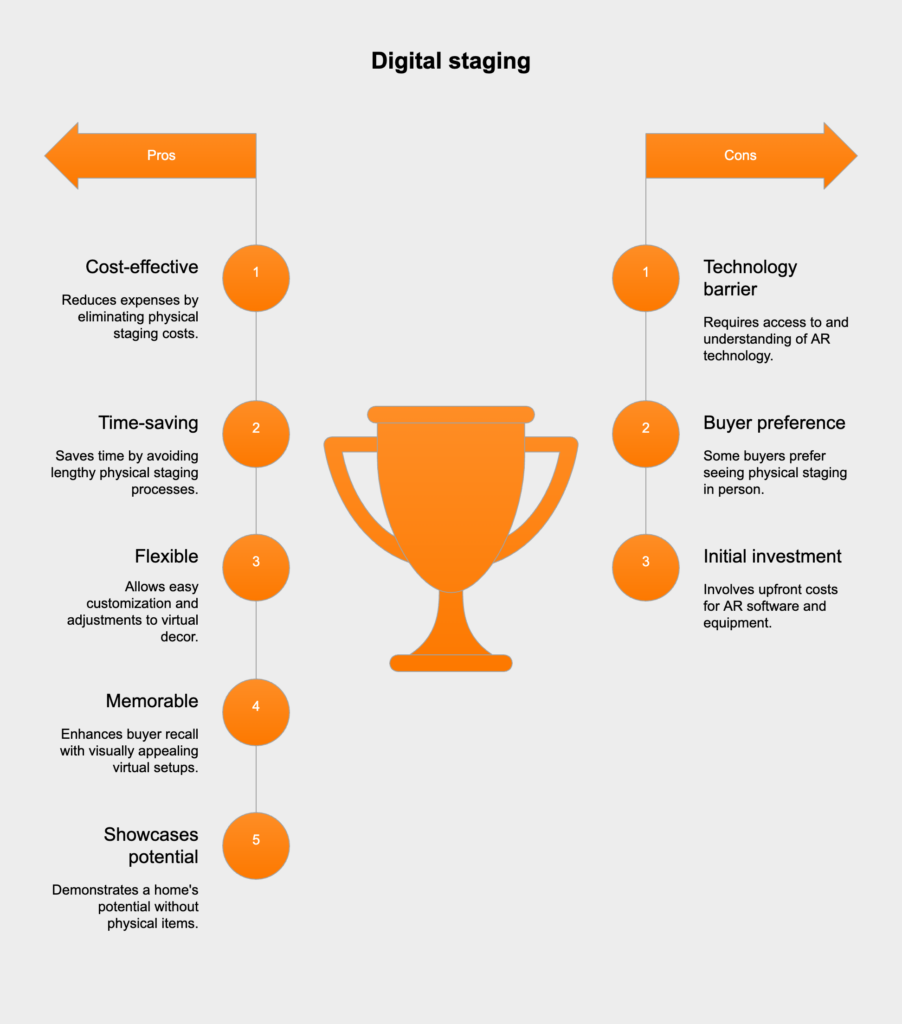
For real estate agents and sellers, virtual tours and AR deliver clear business advantages that streamline work, expand their market, and boost their bottom line. These aren’t just flashy marketing tools; they’re powerful assets that create major efficiencies, provide useful data, and lead to faster, more profitable sales.
The most immediate benefit is a huge boost in efficiency. By using virtual tours as a first-pass screening tool, agents dramatically cut down on the time and money spent conducting physical showings for casual browsers. This means less time traveling and coordinating, and more time focused on qualified, serious buyers. This streamlined approach saves money on marketing and travel while reducing no-shows for viewings.
Geography has always been a major constraint in real estate. Virtual tours and AR effectively remove these borders, opening up a property to a worldwide audience. An agent can now market a listing just as easily to an investor in another country as to a local buyer. This wider reach increases the pool of potential buyers, which can create more competition for the property and lead to a faster sale at a higher price.
By offering a rich digital alternative, these technologies ensure that only the most serious buyers request an in-person tour. This reduction in foot traffic is more convenient for sellers and tightens up the entire sales cycle. The process of moving from initial interest to a qualified lead becomes much quicker. As a result, properties with virtual tours often require fewer physical visits before an offer is made, shortening the time from listing to closing.
A powerful, often overlooked, benefit of digital tours is the data they produce. Virtual tour platforms can track user behavior, giving agents priceless feedback. For example, an agent can see which rooms viewers spend the most time in, what features they inspect closely, and the path they take through the property. This data helps agents refine their marketing and sales pitches by highlighting the home’s most popular features and proactively addressing any areas of concern.
The rapid growth of virtual and augmented reality in real estate is fueled by a range of powerful and increasingly user-friendly technology platforms. These companies provide the tools that allow agents to create, share, and enhance digital property experiences, turning futuristic ideas into practical sales tools.
Matterport has become the industry leader for creating 3D virtual tours. Using its specialized cameras or even just a compatible smartphone, the platform captures spatial data to build a photorealistic and dimensionally accurate “digital twin” of a property. The end result is a smooth, interactive 3D model that anyone can navigate. Matterport’s platform also generates interactive floor plans and lets users add notes within the tour, making it a comprehensive tool for marketing and property evaluation.
For the most immersive experience, VR headsets are unmatched. Devices like the Meta Quest (formerly Oculus Quest) transport users directly into the virtual property. When a buyer puts on a headset, they aren’t just looking at a screen—they are standing “inside” the home. This level of immersion is incredible for conveying a true sense of space and atmosphere. VR headsets are perfect for delivering high-impact tours and hosting remote launch events for new developments.
Platforms that specialize in augmented reality, like PropVR, focus on visualization and customization. Their tools power AR-enhanced walkthroughs where users can modify their environment in real time. Platforms like PropVR are excellent for real-time customization and visualizing renovations, letting a buyer see how a new kitchen or different flooring would look before making a commitment. This is particularly valuable for off-plan and fixer-upper projects.
For virtual tours to be effective, they must be easy to access and share. Cloud-based platforms like Lens360 specialize in creating and hosting 360° virtual tours that are simple to build, edit, and distribute. These tours can be embedded on a website, shared with a link, and viewed on any device without special software. The main advantage of these platforms is their focus on easy editing and wide distribution, making virtual tours a scalable and simple addition to any marketing plan.
The integration of AR and VR in real estate is just getting started. As the technology gets better and more woven into our daily lives, its role in property deals will only grow. The future is heading toward a world where remote-first interactions are standard, and digital tools are used not just for sales but across the entire property lifecycle.
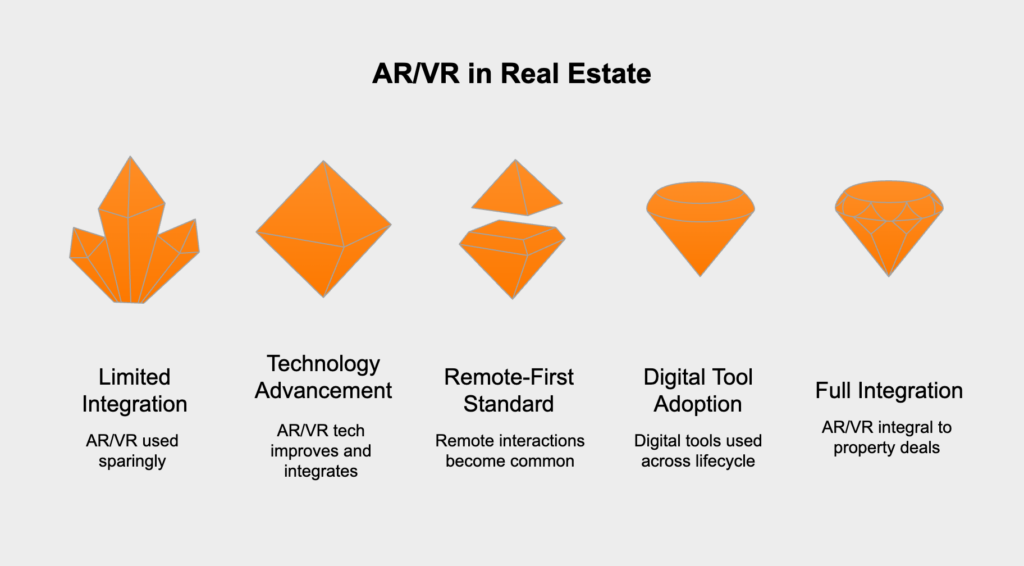
The biggest driver of the future is accessibility. As the cost of VR headsets drops and the AR power of smartphones grows, these technologies will shift from being a premium feature to a standard expectation. The software is also getting simpler, making it easier than ever for agents to create their own tours. This trend toward widespread adoption will soon make AR and VR essential tools for any competitive real estate agent.
The buyer’s journey is quickly becoming remote-first. Thanks to globalization, busy schedules, and a general comfort with digital tools, more buyers will start their search, conduct detailed viewings, and even make offers based on virtual experiences. This doesn’t mean physical visits will disappear, but it does shift their role to being a final confirmation step rather than an initial look. For agents who want to reach global markets, these technologies will be absolutely essential.
Of course, widespread adoption depends on clearing a few hurdles. The quality of a virtual tour is everything—a blurry or clunky scan can do more harm than good. At the same time, some buyers and sellers may still be uncomfortable with these digital tools. The industry must prioritize a high-quality user experience and promote digital literacy to make sure everyone can benefit.
Looking ahead, the use of AR and VR will extend far beyond the sales process. For instance, AR simulations are being explored as a highly effective tool for training new real estate agents. After a sale, AR could help new homeowners with maintenance by overlaying instructions onto appliances or home systems. This expansion into training and homeowner support will cement AR and VR as foundational technologies for the entire real estate industry.
